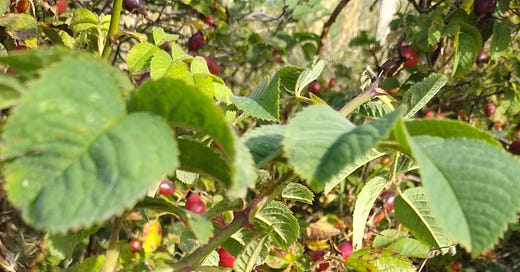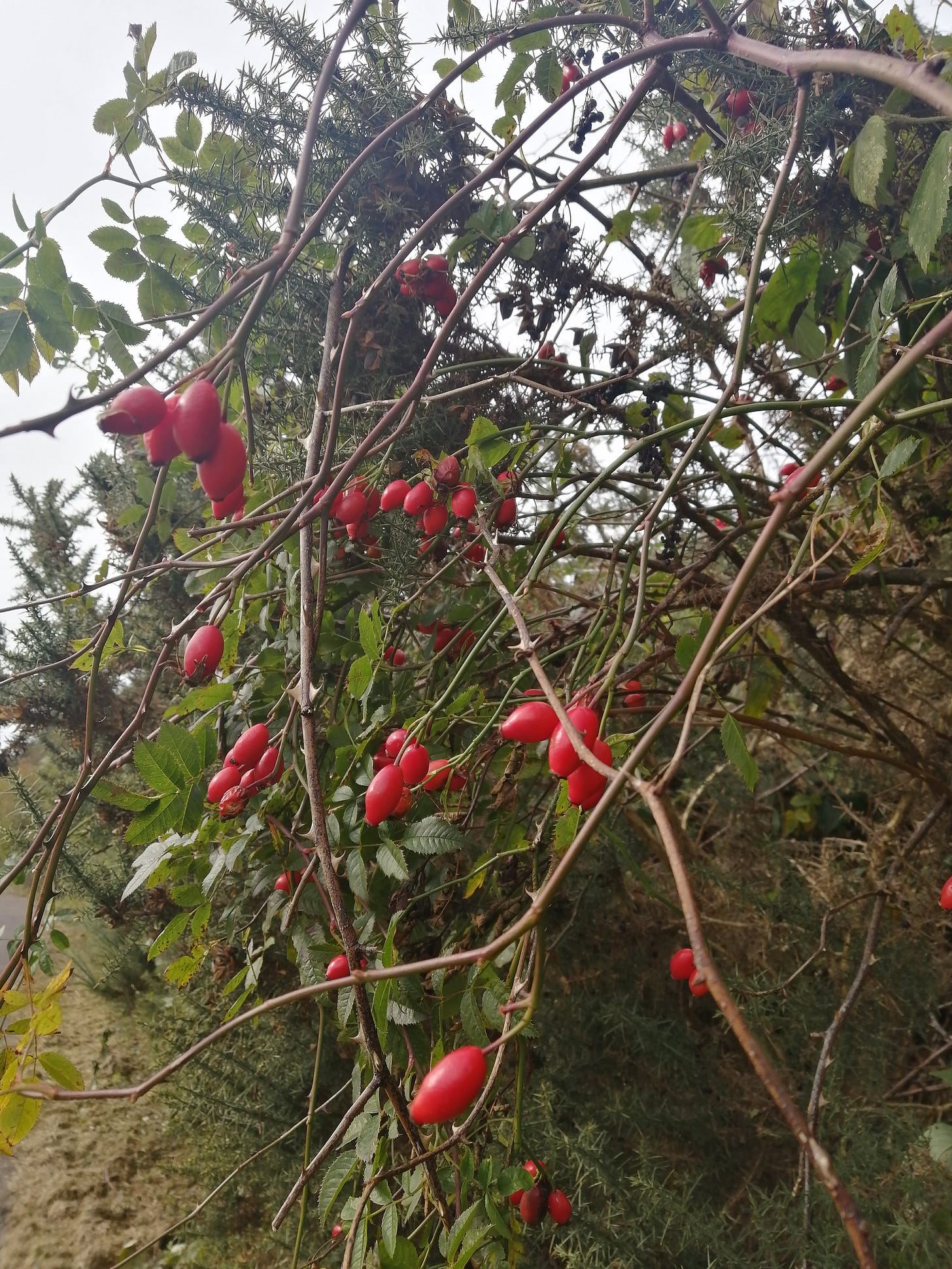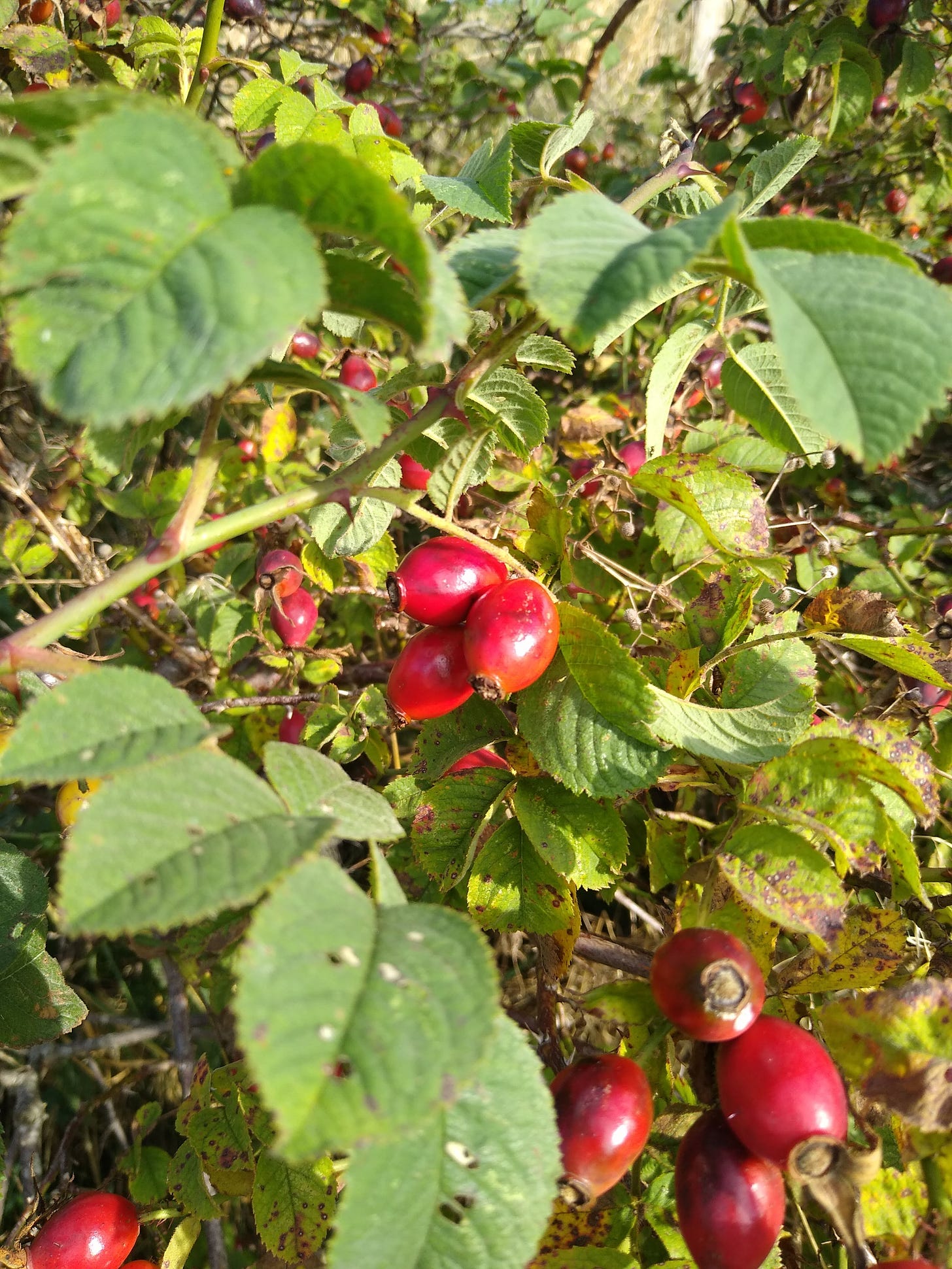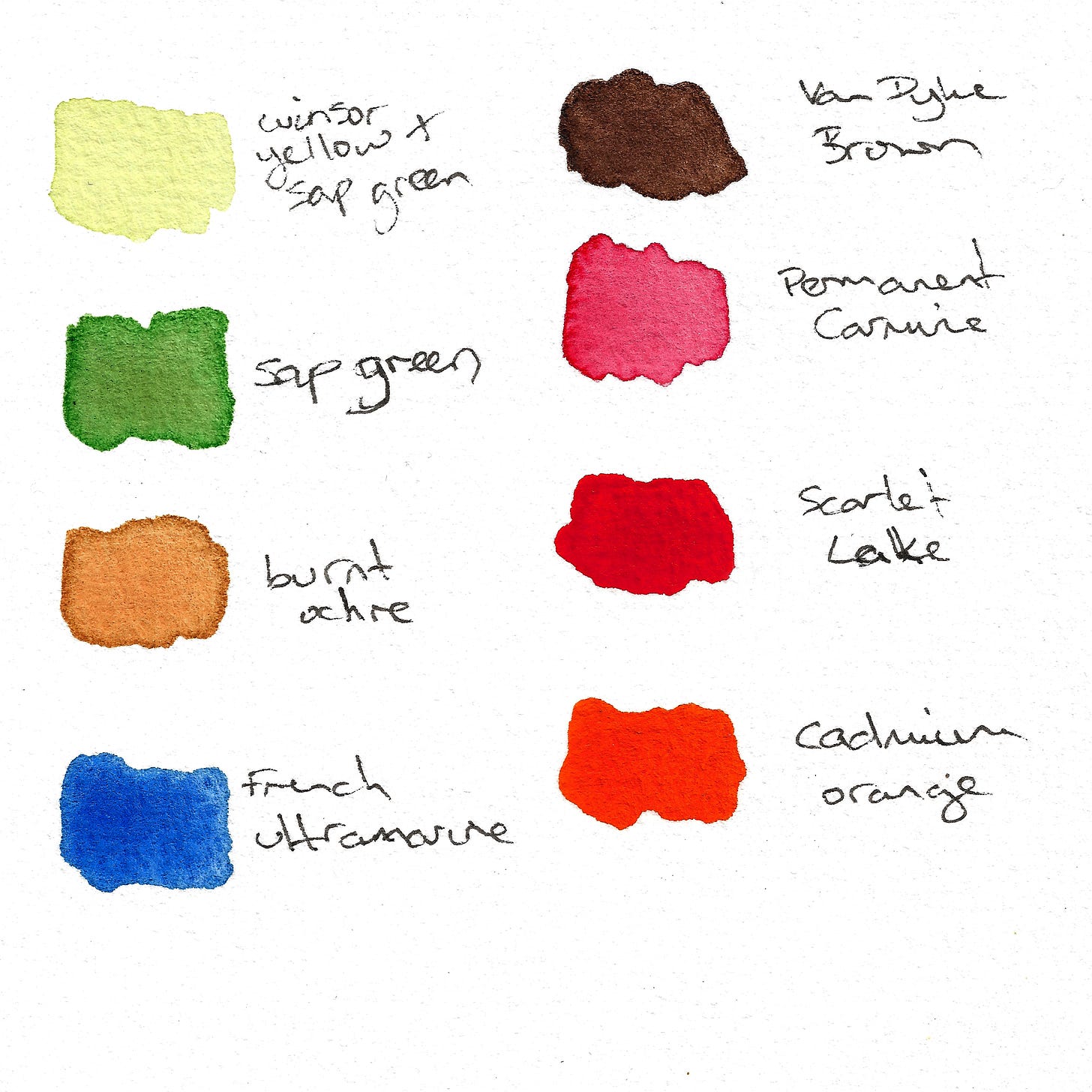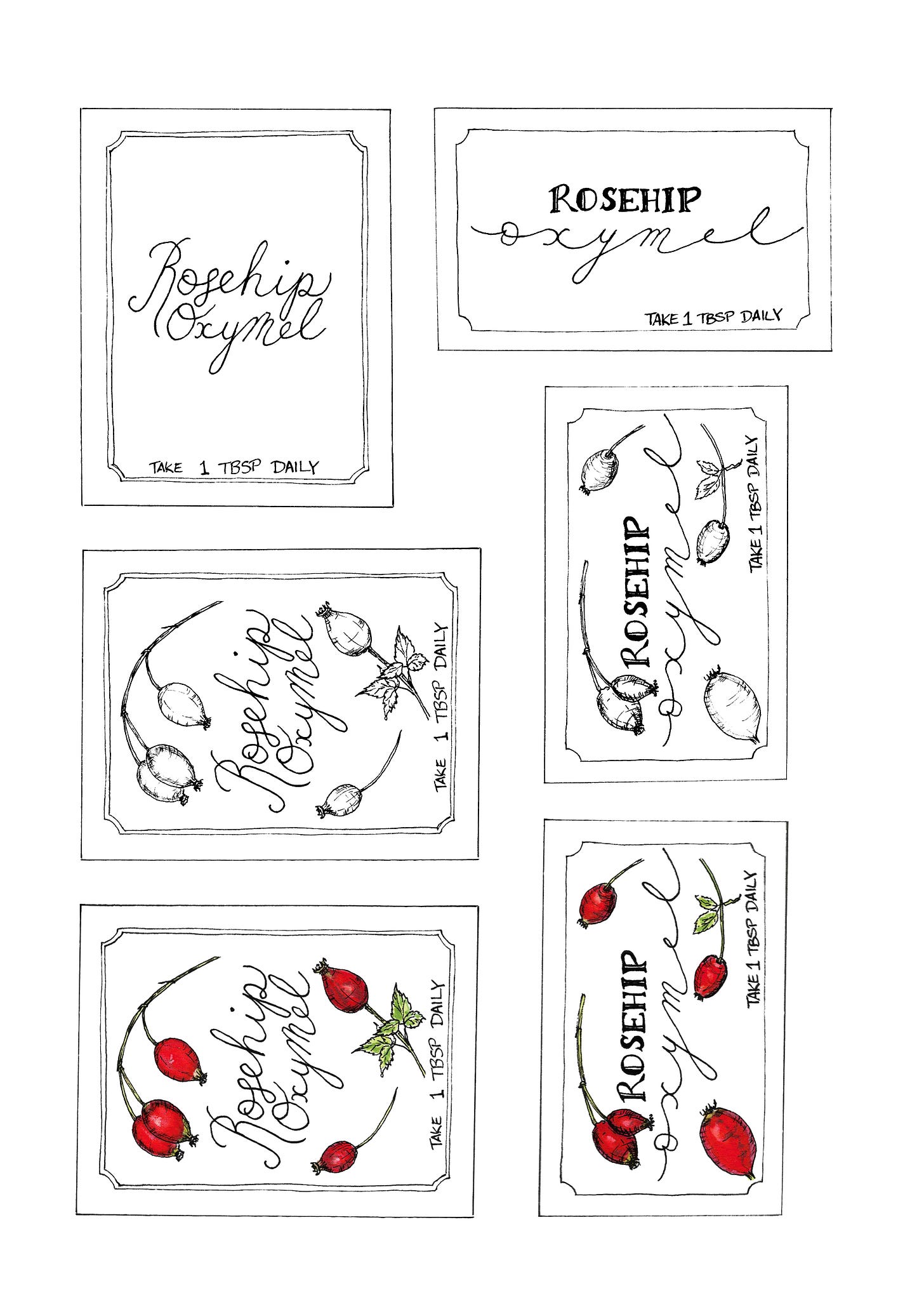Hi! We’re Jo & Ali and we both live in Berwick-upon-Tweed in North Northumberland in the UK. We share a love of all things nature and being outdoors - as well as connecting to the world around us through a range of creative practices. We thought it would be nice to team up on a seasonal topic - you’ll find here some of our writing about rosehips, how to use them to support your immune system during the darker months and how to really notice their shape, form and colour for the purposes of illustrating these little parcels of joy!
[Jo will kick-off by talking to you about rosehips and how they can be enjoyed as a seasonal treat]
The world this month in our landscape is turning to decay, fading to muted browns and greens interspersed with deep russets, highlighted by sparkling dew or frost in the mornings. The proud stems of grasses and creeping thistle are back-bent, bowing towards the Earth, making crooked homes for spiders to weave their webs in. The foliage blackens with alacrity once the frosts set in, and now swathes of tree-fallen leaves collect at the corners and path edges, giving more brown to the colour palette of the season. But what are these glistening, bright and fearless berries that dot the hedgerow?
In ones and twos they poke out from their thin and reaching stems, full and bulbous at the base, elongating at the tip, sometimes with a ragged crown of blackened and withered sepals. They catch the eye and draw us in to them, and they bring a smile out of me no matter how distracted my mind, or how heavy my heart.
The plant is the wild Dog Rose, Rosa canina, the being that romps through the hedges in summer, creating long curved arches of green leaves and small, simple, 5-petalled pale pink flowers. Rose is an ally of the heart in so many ways. Their medicine in the flowers and the hips (berries) nourish the physical heart, supporting cardiac function as a vulnerary and aiding tissue repair, as well as lowering blood pressure and cholesterol. Rose has been used for centuries to treat eye complaints and more recently in the Second World War in the UK rosehips were collected en masse by children, in order for communities to make Rosehip Syrup which is a high Vitamin-C immune-boosting (and tasty) medicine. The berries work well against colds, flu and viruses. Energetically, all parts of the Rose are symbolic of love and the heart, but I would say that wild Dog Roses in particular are more symbolic of self-love. They can help us work with our boundaries, opening our hearts to love, allowing us to see our true nature and supporting our self care journeys.
A couple of recipes…my favourite things to do with Rosehips
Rosehip syrup is an easy-to-find recipe on the internet, or in foraging books, and if you’ve never made it before I’d encourage you to look it up and try it. The taste is wonderful, somewhere between the scent of roses and the taste of cherries, and it is so supportive to our bodies and immune systems at this time of year and right through the Winter. Having said that, I try to intake much less refined sugar than ever before, so I prefer this recipe:
Rosehip Oxymel
Oxymels are half vinegar, half honey solutions in which to preserve medicinal plants and the method is so simple. In my last post I go into more detail about how to create an Oxymel, so do read that if you haven’t already. For a purely Rosehip version of this Oxymel, I gather enough hips to fill my jar (of any size) most of the way. When I get home from picking them, I tip them out and pull off the stalks or stray leaves, and prick each berry a couple of times with a fork or toothpick, just to pierce the skin to help the process. I put them back in the jar and cover them with Organic Apple Cider Vinegar, putting on a lid with a square of greaseproof paper to protect the lid from rusting. I label this and keep it in a dark cupboard for 4 weeks to infuse. I then strain the mixture, returning the Rosehips to the land, and add enough honey to the jar, stirring to dissolve it, until it tastes good to me! This might be up to 50-50 infused vinegar to honey, or it might be less honey.
The second recipe I’d like to share is one for celebrations and gatherings. I don’t have a lovely photo of it because these usually happen outside, in the dark, and we’re too busy enjoying ourselves to take a photo! Warming apple juice over a stove, or fire outside is the basic premise of this recipe; it’s child-friendly, alcohol-free (but doesn’t have to be), and fun to get others involved with.
Mulled Rosehip Apple Juice
Buy the best apple juice you can afford - local and freshly pressed is best, but Cawston’s is good, and in most supermarkets in the UK. Pour the amount you want to make into a large saucepan and start to gently heat it, trying not to let it boil at all.
Add in spices that you like: a cinnamon stick, slices of fresh ginger, grated nutmeg, cardamom pods, a bay leaf. Slice some fresh fruit to put in: a couple of wild or homegrown apples are best, but it could be an orange or clementine.
Next add in a generous slug of either Rosehip Oxymel or Rosehip Syrup, and then get the children of the group (or the most fun-loving adults) to pick rosehips and put them in the pot. You can also add in Hawthorn berries if you have them nearby. Let the mixture heat up and infuse for 10-20 minutes, without it simmering or boiling, and serve it hot.
[Ali will now give you some tips for how to study your rosehips (pre-cooking!) in order to create an illustrated label for your Rosehip Oxymel.]
Sketching Dog Rose (Rosa canina) hips
If you are going to sketch some rosehips - either ones you've foraged to make one of Jo's delicious recipes, or ones you've come across on a walk - take some time to really look at them before you start.
The first thing to look closely at is their shape; I'd always considered rosehips to be a basic 'tear drop' shape, but on closer examination the hips of the dog rose are actually more bulbous, with a 'blunt' end where the stamens have withered to small, brown 'hairs'.
Next, notice whether the hips are clustered in groups or are on their own, as well as the length of the stem attaching the hip to the rest of the plant. Does the stem have any thorns? Are there any small leaves where the hip stem joins the main branch of the plant? Do the stems still have full leaves? If so, notice their shape and how they are arranged (rose leaves are usually arranged in sets of at least three; each leaf is a tapered oval in shape, with serrations around the edge).
And finally, what colours can you see across the rosehip/stem/leaves? Some hips are very orangey-coloured, whilst others are bright red or deep crimson - or they might have each of these colours contained within one hip. Where are the shadows and the highlights? You'll need to be able to identify these different areas to create a realistic-looking illustration.
Now that you've thoroughly examined your rosehips, you're ready to start sketching!
I used an HB pencil and a 0.05 fineline pen for the first three stages of my illustrations, working onto a hot pressed watercolour paper (hot pressed paper is smoother and takes ink lines more fluidly - but do use a textured paper if you prefer).
I start in pencil first, to get the rough shapes down onto my paper, paying attention to where things overlap.
I then inked my outline with a fineline pen, getting rid of any pencil guides and mistakes.
And finally, I added some detail. This can include curved lines to indicate the direction of the form, hatching for shadows and any little bumps and imperfections on the surface. You can add as much or as little detail as you’d like and have the patience for.
I used a selection of Winsor & Newton professional watercolours for the next stage of my illustration, in the following colours:
First, I painted in the shadows in a very light wash of my French Ultramarine as well as the green tips of the hips and the stalk.
I let this dry slightly before I added a light wash of my Cadmium Orange where those more orange tones can be seen and, whilst this layer was still wet, I blended in washes of my Scarlet Lake and Permanent Carmine. I ‘lifted out’ some of the wet paint - with a clean, dry brush - in areas where I could see highlights. Finally, I added a couple of patches of burnt ochre and vandyke brown where there were little imperfections and marks on the surface of the hips and the stem.
Once you’ve practiced drawing, inking and colouring your rosehips, you might want to create a label for your Rosehip Oxymel.

I’ve created a sheet of templates that you can use to help you with this. They include labels with just the hand-lettering, one with the inked outlines of the rosehip illustrations and also my finished illustrated labels, just in case! There is x1 portrait and x1 landscape version of each label template, so you can choose the one that best fits your bottle. [Right click the image and choose ‘save image as…’ to download the templates].
Happy hipping! And I’d love to see your rosehip illustrations and/or your finished illustrated labels.
We hope you enjoyed this collaborative article on the topic of rosehips! If you’d like to find out more about our publications here on Substack, you can find Jo at Wild Revival and Ali at Drawn to Nature.

